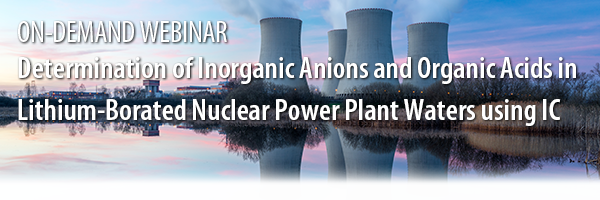In this on-demand webinar you will learn how a continuously regenerated trap column removes interference from mg/L concentration of either lithium or ammonia in samples, and how ion chromatography with suppressed conductivity detection is the safe and reliable method of choice to determine both µg/L (ppb) and mg/L (ppm) levels of anions and cations including transition metals in power plant waters.

Format: On demand
Duration: Approximately 35 minutes
Successful operation of a nuclear power plant (NPP) demands careful control and monitoring of water chemistry in primary coolant dosed with boron and lithium, steam generator tubes dosed with ammonia, closed cooling water systems dosed with nitrite and other structural parts that are subject to corrosion and crud deposition. This can affect plant operation and radiation exposure during refueling downtime. Find out how the role of ion chromatography can achieve this goal.
By viewing this presentation you will learn:
- how the new Thermo Scientific™ Dionex™ CR-TC Continuously Regenerated Trap Column (CR-CTC III) removes interference from mg/L concentration of either lithium or ammonia in samples
- how ion chromatography with suppressed conductivity detection is the safe and reliable method of choice to determine both µg/L (ppb) and mg/L (ppm) levels of anions and cations including transition metals in power plant waters.
Presenter
 Peter O’Brien
Peter O’Brien
(Systems Engineer, EDF Energy, UK)
Peter O’Brien has been a chemist at Sizewell B Nuclear Power Plant since 2006. He joined as a chemistry apprentice and graduated as a shift chemistry technician before progressing into the position of Chemistry Lab Team Leader. While an apprentice, a chemist with over 40 years of lab experience mentored him and, together, they were the ion chromatography specialists at the time. When the chemist retired in 2008, Peter took over the specialist role. To-date, he has accrued 16 years of experience with ion chromatography at a nuclear power plant.
Peter’s achievements to date include working with Thermo Fisher Scientific to move lithium and sodium determination away from flame atomic absorption using unstable explosive acetylene to a far safer method using liquid ion chromatography, and improving levels of precision and accuracy measuring sub-µg/L concentrations of primary coolant and feed water anion and cations. This has been achieved through the addition of continuously regenerated cation trap columns (CR-CTC) with the company's sample preparation. The next goal is to further improve sub- µg/L limit of detection using an autosampler to enhance sample preparation and dilution.
Sponsor:


